Currency collections can take many forms. Some people collect coins from different countries, while others focus on paper bills from a certain era. Some collectors try to amass as many examples as possible, while others focus on quality over quantity. No matter what form it takes, currency collecting can be a rewarding hobby.
If you have a 1967 quarter in your pocket, it might be worth more than 25 cents. In fact, it could be worth quite a bit more. The value of a 1967 quarter depends on a few factors, including its condition and the year it was minted. Here is a closer look at the value of 1967 quarters!
Why are There no Mint Marks on 1967 Quarters?
Mint marks are small letters or symbols used to indicate which mint produced a particular coin. For example, coins from the Philadelphia Mint have a “P” mint mark, while those from the Denver Mint have a “D.” The 1967 quarters are unique in that they don’t have any mint marks.
In the early 1960s, the price of silver began to rise, leading to a coin shortage. People began hoarding silver coins, including quarters, in an effort to profit from the increasing value of the metal. As a result, there were too few coins available in circulation, leading to difficulties for businesses and consumers alike.
In 1967, the U.S. Mint decided to stop using mint marks on coins, believing that the practice led people to save coins rather than spend them. The Mint felt that this was counterproductive to their mission of circulating coinage. In addition, they believed that removing the mint marks would create a more uniform appearance for coins, making them less likely to be discriminated against by businesses. Ultimately, the Mint’s decision to remove mint marks from coins was a controversial one, but it remains in place to this day.
Are 1967 Quarters Considered Rare Coins?
Most people think that all coins minted in 1967 are worth a small fortune. However, this is not the case. In fact, 1967 quarters with no mint mark are actually quite common. So, if you come across one of these quarters, don’t get too excited – it’s not a rare find. Instead, enjoy the fact that you’ve uncovered a little bit of history. But who knows? With a little bit of research, you might just find out that your quarter is worth more than you think.
What Does a 1967 Quarter Look Like?
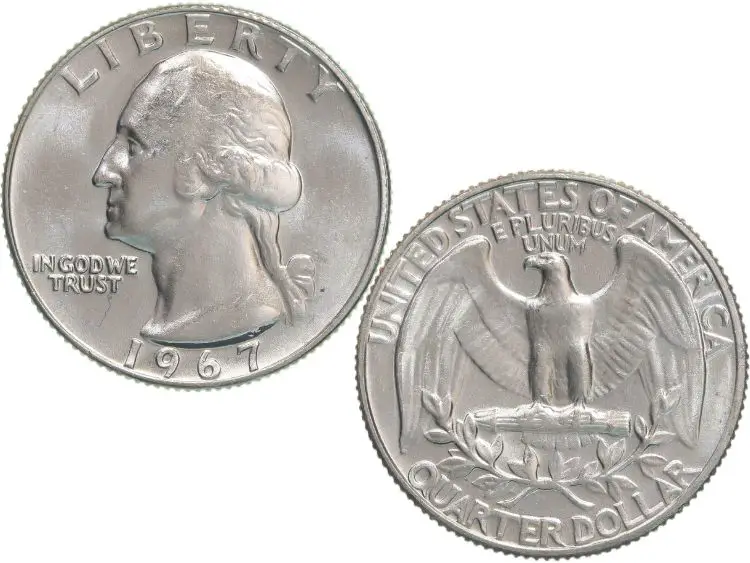
Other than the fact that a 1967 quarter doesn’t have a mint mark, what does this coin actually look like? Let’s take an in-depth look!
The 1967 quarter is a silver coin composed of 90% silver and 10% copper. It weighs 6.25 grams and is 24.26 mm in diameter. As for the design, the obverse side of the 1967 Quarter depicts the head of George Washington, the first US President facing the left. The word “LIBERTY” is written above the head, while the year 1967 is placed below, and on the lower left side is the phrase “IN GOD WE TRUST”.
The reverse of the 1967 Quarter shows an eagle standing on a bundle of arrows with an olive branch in its beak. Above the eagle are the words “United States of America” and below it is the phrase “E Pluribus Unum” meaning “Out of many, one,” in Latin. All in all, the 1967 Quarter is a beautiful coin that represents an important time in American history.
Factors That Determine the Value
While most 1967 quarters are only worth their face value of 25 cents, there are a few rare varieties that are worth considerably more. The three main factors that determine the value of a 1967 quarter are condition, rarity, and mint set. Additionally, a coin with an error can be worth more than its face value.
Thus, when determining the value of a 1967 quarter, it is important to consider all of these factors. With a little bit of research, even a novice collector can find some truly valuable coins.
Condition
The value of the 1967 Washington quarters is determined by several factors, but the most important factor is its condition. Well-preserved coins will be worth more than those that show signs of wear and tear. For example, a coin that has been circulated will typically have a lower value than one that was never put into circulation.
Similarly, a coin that has been cleaned or otherwise tampered with will usually be worth less than one that is in its original condition. Because the condition of a coin can be difficult to determine, it is always best to consult with a professional coin grading service before making any decisions about its value.
While there are a number of different ways to grade coins, the Sheldon Scale is one of the most commonly used. The Sheldon Scale ranges from Poor (PO-1) to Perfect Uncirculated (MS-70), with each grade representing a coin’s condition and value. Coins that are graded Poor typically have heavy wear and tear, while those that are graded Mint State are considered to be in pristine condition.
The Sheldon Scale is important for collectors because it provides a consistent way to determine a coin’s value. When buying or selling coins, both parties can refer to the Sheldon Scale to ensure that they are agreed upon the value of the coin. For example, a mint state coin is worth more than a poor coin, so the seller may try to get a higher price if they believe the coin is in mint state condition. By having a common grading scale, buyers and sellers can avoid disagreements and ensure that everyone is on the same page.
Rarity
The value of a 1967 quarter is determined by a number of factors, but rarity is one of the most important. There are several varieties of the 1967 quarter that are considerably rarer. For example, 1967 quarters with off-center errors are always interesting to collectors. Similarly, clipped planchets and broad strokes on coins are other things worth looking out for.
A doubled die quarter is a coin that has been struck twice by the die, resulting in a doubled image. These coins are highly sought after by collectors and can be worth a considerable amount of money. Doubled die quarters are fascinating items, and their rarity makes them all the more desirable to collectors.
If there is high demand for a particular variety or condition, the price will go up. In conclusion, rarity is an important factor when determining the value of a 1967 quarter, but it is not the only factor to consider.
Mint Set
The value of a 1967 quarter is determined by a number of factors, but the most important factor is the mint set. Are your coins part of the regular or special mint sets?
In 1967, the United States Mint began selling a new type of coin set to collectors. These sets, known as special mint sets (SMS), contained coins that were of a higher quality than typical circulation strikes. The coins in SMS sets featured more reflective finishes than typical uncirculated coins, and many collectors considered them to be more desirable. The U.S. Mint made 1,800,000 special mint sets in 1967, and they remained popular with collectors for years. Today, SMS sets are highly sought-after by numismatists and can fetch high prices at auction.
How Much is a 1967 Quarter Worth?
In 1967, the United States Mint produced more than 1.5 billion quarters. Unlike some earlier quarters, which were made with silver, all 1967 quarters were made with a base-metal copper-nickel clad format. As a result, they are not rare and are only worth their face value of 25 cents.
While some coin collectors may be disappointed by this news, the fact that 1967 quarters are readily available means that anyone can start or expand their collection without breaking the bank. However, if you have a quarter that’s in good condition, it could be worth more to a collector. For example, a 1967 quarter graded MS-66 sold recently for $18 on eBay.
The most valuable 1967 quarter is the one that was graded MS68 by Professional Coin Grading Service (PCGS). This coin sold for more than $8,000 at auction in 2017, making it one of the most valuable quarters ever sold. The coin’s high grade is due to its strong strike and beautiful luster.
As you can see, the condition can play a huge role in determining the value of your Washington quarters.
How Much is a 1967 SMS Quarter Worth?
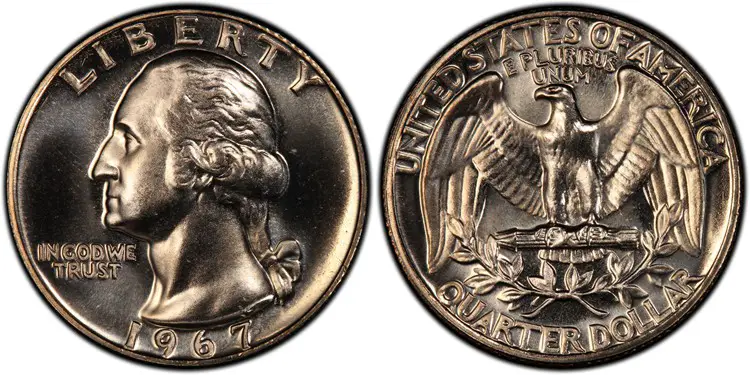
1967 SMS Quarter
The 1967 SMS quarter was not intended for circulation, and it has several features that set it apart from a regular quarter. These San Francisco mint coins were made with a proof finish, meaning they were heavily polished before being struck. As a result, the design elements have highly reflecting fields and crisp, frosted detailing. addition, these quarters were minted with a specially enhanced die that gives the impression of depth and dimensionality.
In circulated condition, the coin is worth about $2-5. Recently, one 1967 SMS quarter sold on eBay for a little more than $3. However, the coin can command a higher price if it is in excellent condition. A virtually flawless 1967 quarter displaying incredible mirroring and contrast sold for $4,700 on Heritage Auctions back in 2016!
So, if you come across one of these quarters, be sure to hold onto it! It could be worth quite a bit of money someday.
How Much is a 1967 Doubled Die Quarter Worth?
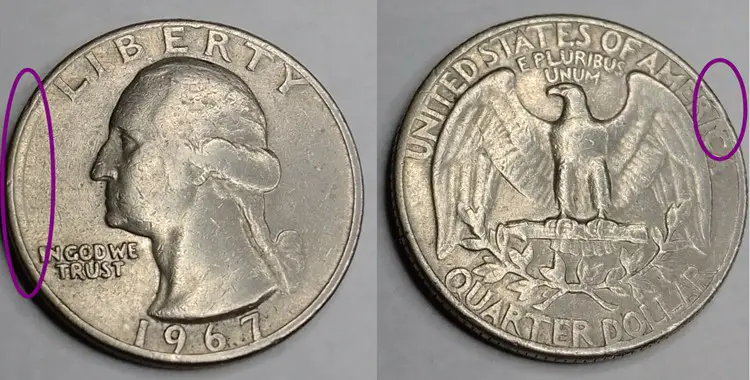
Most people don’t give much thought to the coins in their pocket, but for some collectors, these small pieces of metal can be worth a fortune. One of the most valuable coins is the 1967 doubled die quarter. This error coin was created when the die used to stamp the quarters was misaligned, resulting in a double image on the coin.
Because of the way the quarters were struck, only a small percentage of the coins actually developed the doubled die variety. To the naked eye, the effect is very subtle, but with a magnifying glass it’s possible to see.
Recently, one example sold for $35 on eBay, but depending on their condition, these coins can be worth anywhere from $25 to $100 or more. So next time you’re rummaging through your change jar, keep an eye out for this rare and valuable coin.
How Much is a 1967 Off-Center Quarter Worth?
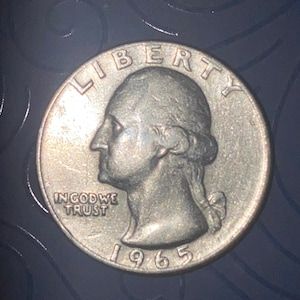
When a coin is struck off-center, it means that the blank failed to enter the collar during the minting process. As a result, the image on the coin is not centered. Off-center strikes are considered to be errors, and they are highly sought after by collectors. In some cases, an off-center strike can be worth hundreds or even thousands of dollars.
When it comes to a 1967, off-center coins can be worth anywhere between $50 to $200. The value of an off-center coin depends on how much of the design is visible. A 1967 quarter that is 10% to 25% off center could be worth $50 to $100, whereas one that shows 50% of the design missing yet offers a completely visible date can take $200 or more.
How Much is a 1967 Quarter Rim Error Worth?
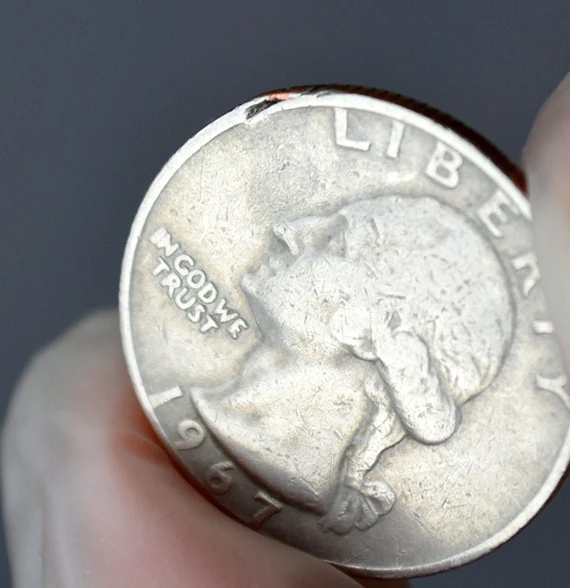
Clipped planchets and broad strokes are two of the most common errors found on coins. A clipped planchet is a coin that has been cut incorrectly, resulting in uneven or missing edges. A broad stroke is a line that appears on the surface of a coin that was not intended to be there. Both of these errors can significantly increase the value of a coin. However, it’s important to remember that not all damage to a coin is considered an error.
Recently, a clipped Washington quarter coin sold for around $11. These errors are relatively common on circulated quarters from 1967, and they can be worth anywhere from $5 to $10. Broadstrikes, on the other hand, are much less common, and they can be worth $20 to $30 or more!
So, if you come across a misprint on a coin, it might be worth checking to see if it’s valuable.
How do I Know if My 1967 Quarter is Worth Anything?
If you’re lucky enough to have a 1967 quarter, then you might be wondering how much it’s worth. A 1967 quarter coin can be easily appraised by looking up its value in a coin catalog. However, if you don’t have a coin catalog handy, there are still several ways to determine the value of your 1967 quarter.
The best way to get an accurate appraisal of your coin’s value is to compare it to similar items that have recently been sold. You can do this by searching online auction sites like eBay. Pay attention to the condition of the coin, as well as any unique features that it may have.
Another option is to take your coin to a local coin dealer. Dealers typically have a good understanding of the current market values of coins and can give you an accurate appraisal.
Finally, you could also submit your coin to a professional grading service. These services will grade your coin and provide an estimate of its value. With a little research, you should be able to easily find the value of your 1967 quarter coin.
Helpful Resources
Here are some helpful resources if you’re looking to buy or sell collectible coins:
- Coin Collecting for Beginners: A Complete Guide to Start Your First Coin Collection for Hobby or Business and Learn how to Find and Value the Best Coinsby Matthew Gray
- Coin Collecting: The Complete Guideby John N. Russell
- The Coin Collector’s Survival Manual, Revised Seventh Editionby Scott A. Travers
What to Do with Your 1967 Washington Quarters
If you have a 1967 Washington quarter, then you may be wondering what to do with it. One option is to sell the coin to a collector or dealer. However, you may also want to keep the coin as a memento or store it in a safe place in case its value increases in the future.
Selling Your 1967 Quarters
There are a few options available when it comes to selling a 1967 Quarter. Numismatic shops specializing in coins can offer the best price, but they can be difficult to find. You can find coin dealers near you with the help of the American Numismatic Association website. Just enter your location and you’re good to go.
Local coin clubs may also be interested in purchasing the coin, and American Numismatic Association offers a Coin Club Directory as well! Online forums like The Coin Community or Coin Talk dedicated to coin collecting can put you in touch with potential buyers from around the world.
eBay is a popular choice for many sellers, as it offers a wide audience and relatively low fees. However, it can be difficult to stand out from the competition on eBay, and buyers may not be willing to pay as much as they would at a specialized auction house.
Heritage Auctions is one of the leading auctioneers of rare coins, and selling your quarter through them can fetch a higher price. However, their fees are also higher, and the process can be more complicated than selling on eBay.
Ultimately, the best option for selling your 1967 Quarter depends on your individual circumstances.
Tips for Selling
If you’re lucky enough to have a 1967 quarter, you may be wondering how to go about selling it. Here are a few tips to help you get the best price for your coin:
- Take a close look at the condition of the coin. If it is in good condition, it will be worth more than a coin that is heavily worn
- Do some research to find out how much similar coins have sold for in the past. This will give you a good idea of what to expect in terms of prices.
- You can also take your coin to a reputable dealer or auction house. They will be able to give you an accurate appraisal of your 1967 quarter value.
- Be sure to list your coin in an online auction or on a reputable numismatic website. Take good pictures and provide detailed information about the coin.
- Finally, make sure that you are realistic about your expectations. Remember that coins are only worth what someone is willing to pay for them.
By taking these steps, you can be sure that you get the best possible price for your 1967 quarter coin.
Storing Your 1967 Quarters
If you’re a collector, you know the importance of keeping your coins in good condition. After all, the 1967 quarter value is determined largely by its condition. That’s why it’s so important to store coins properly, in order to prevent them from being damaged by dirt, dust, or moisture. If you’re selling, prospective buyers will want to see that your coins are well-protected, and that they’re being stored in a way that will preserve their condition.
Coins can be stored in a number of ways, including albums, folders, tubes, and trays. Many coin collectors prefer albums, as they allow for easy organization and display. However, whichever storage method you choose, make sure that it is acid-free and archival quality; otherwise, it could damage your coins over time.
Once you have chosen a storage method, the next step is to clean your coins. Gently wipe them with a soft, dry cloth to remove any dirt or debris. Do not use any harsh chemicals or cleaners, as these can damage the surface of your coins. If your coins are especially dirty, you can soak them in distilled water for a few minutes before gently cleaning them with a soft brush. After cleaning, it is important to dry your coins completely before storing them as moisture can cause corrosion and other damage.
Final Thoughts
In conclusion, a regular 1967 quarter is worth about 25 cents. However, the value may be higher or lower depending on the condition of the coin and the current market conditions. For example, uncirculated coins may be worth more. Conversely, if the coin is in poor condition and there is low demand, it may be worth less.
However, it is always worth checking to see if your quarter has any errors or die varieties, as these can significantly increase its value. So, before you spend that old quarter, be sure to do some research and find out how much it might be worth! You might just be surprised at what you find.
